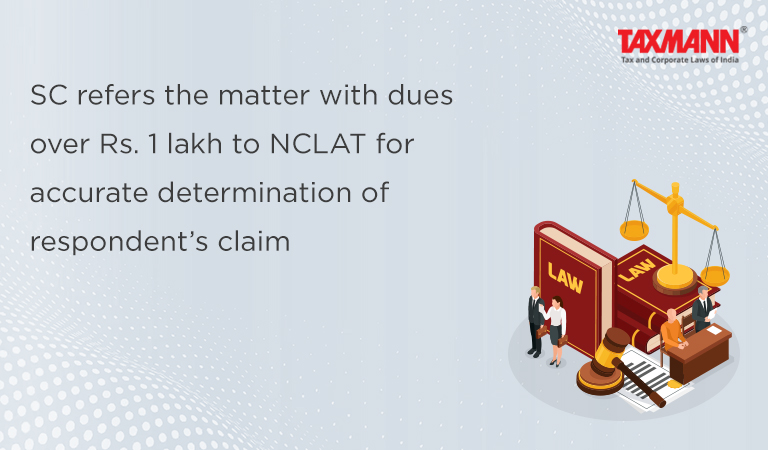SC refers the matter with dues over Rs. 1 lakh to NCLAT for accurate determination of respondent’s claim
- Blog|News|Insolvency and Bankruptcy Code|
- 2 Min Read
- By Taxmann
- |
- Last Updated on 1 May, 2023

Case Details: Compack Enterprises India (P.) Ltd. v. Jitendra Impex (P.) Ltd. - [2023] 149 taxmann.com 417 (SC)
Judiciary and Counsel Details
-
- A.S. Bopanna & Dipankar Datta, JJ.
- Mahesh Agarwal, Rajesh Banati, Ashish Sareen, Vikram P. Singh, Ms Aanchal Mullick, Ankit Banati, Advs. & E.C. Agrawala, AOR for the Appellant.
- Dhruv Mehta, Sr. Adv. Vikas Mishra, Arihant Jain, Sachit Gawri, Aayush Garg, Ms Vidushi Chaudhary, Advs. & Ms Pooja Dhar, AOR for the Respondent.
Facts of the Case
In the instant case, the respondent (i.e. an operational creditor) filed an application u/s 9 of the IBC against the appellant (i.e. the corporate debtor) on the ground that the appellant owed a claimed amount.
However, the application was dismissed by the Adjudicating Authority (NCLT). The NCLT concluded that the claim made was not justified and that the proceedings under the IBC were not sustainable.
Aggrieved by the NCLT’s order, the respondent filed an appeal before the National Company Law Appellate Tribunal (NCLAT).
The NCLAT noted that the respondent claimed an amount of Rs. 1,81,45,943 whereas the appellant contended that only a sum of Rs. 22,56,833 was due to be paid.
In this regard, the NCLAT held that since the sum due was more than Rs. 1,00,000, the section 9 application filed before the NCLT was sustainable, and therefore remanded the matter back to the NCLT.
Then, an appeal was made to the Supreme Court against the order passed by the NCLAT.
Supreme Court Held
The Supreme Court noted that the appellant had offered to pay a sum of Rs. 22,56,833, however, the same was declined by the respondent.
The Supreme Court held that the amount of Rs. 22,56,833 was undisputed and had already been deposited by the appellant before the NCLT. Therefore, the matter was to be remitted back to the NCLAT to undertake an exercise to find out whether any amount more than Rs. 22,56,833 was due, as claimed by the respondent and arrive at its conclusion in accordance with the law. As a result, the appeal was disposed of.
Disclaimer: The content/information published on the website is only for general information of the user and shall not be construed as legal advice. While the Taxmann has exercised reasonable efforts to ensure the veracity of information/content published, Taxmann shall be under no liability in any manner whatsoever for incorrect information, if any.

Taxmann Publications has a dedicated in-house Research & Editorial Team. This team consists of a team of Chartered Accountants, Company Secretaries, and Lawyers. This team works under the guidance and supervision of editor-in-chief Mr Rakesh Bhargava.
The Research and Editorial Team is responsible for developing reliable and accurate content for the readers. The team follows the six-sigma approach to achieve the benchmark of zero error in its publications and research platforms. The team ensures that the following publication guidelines are thoroughly followed while developing the content:
- The statutory material is obtained only from the authorized and reliable sources
- All the latest developments in the judicial and legislative fields are covered
- Prepare the analytical write-ups on current, controversial, and important issues to help the readers to understand the concept and its implications
- Every content published by Taxmann is complete, accurate and lucid
- All evidence-based statements are supported with proper reference to Section, Circular No., Notification No. or citations
- The golden rules of grammar, style and consistency are thoroughly followed
- Font and size that’s easy to read and remain consistent across all imprint and digital publications are applied





